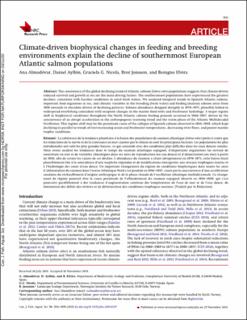| dc.contributor.author | Almodóvar, Ana | |
| dc.contributor.author | Ayllón, Daniel | |
| dc.contributor.author | Nicola, Graciela G. | |
| dc.contributor.author | Jonsson, Bror | |
| dc.contributor.author | Elvira, Benigno | |
| dc.coverage.spatial | Southernmost Europe, Spain | en_US |
| dc.date.accessioned | 2023-03-13T09:45:11Z | |
| dc.date.available | 2023-03-13T09:45:11Z | |
| dc.date.created | 2019-08-26T14:51:48Z | |
| dc.date.issued | 2019 | |
| dc.identifier.citation | Canadian Journal of Fisheries and Aquatic Sciences. 2019, 76 1581-1595. | en_US |
| dc.identifier.issn | 0706-652X | |
| dc.identifier.uri | https://hdl.handle.net/11250/3057890 | |
| dc.description.abstract | The consistency of the global declining trend of Atlantic salmon (Salmo salar) populations suggests that climate-driven reduced survival and growth at sea are the main driving factors. The southernmost populations have experienced the greatest declines, consistent with harsher conditions in natal fresh waters. We analyzed temporal trends in Spanish Atlantic salmon, important food organisms at sea, and climatic variables in the breeding (fresh water) and feeding (marine) salmon areas from
1950 onwards to elucidate drivers of declining patterns. Salmon abundance dropped abruptly in 1970–1971, plausibly linked to widespread overfishing coincident with incipient changes in the marine food webs and freshwater hydrology. A major regime shift in biophysical conditions throughout the North Atlantic salmon feeding grounds occurred in 1986–1987, driven by the concurrence of an abrupt acceleration in the anthropogenic warming trend and the warm phase of the Atlantic Multidecadal Oscillation. This regime shift may be the proximate cause of the collapse of Spanish salmon observed in 1988–1989, which kept
declining in parallel to trends of ever-increasing ocean and freshwater temperatures, decreasing river flows, and poorer marine trophic conditions. | en_US |
| dc.language.iso | eng | en_US |
| dc.rights | Navngivelse 4.0 Internasjonal | * |
| dc.rights.uri | http://creativecommons.org/licenses/by/4.0/deed.no | * |
| dc.subject | Atlantic salmon | en_US |
| dc.title | Climate-driven biophysical changes in feeding and breeding environments explain the decline of southernmost European Atlantic salmon populations | en_US |
| dc.type | Peer reviewed | en_US |
| dc.type | Journal article | en_US |
| dc.description.version | publishedVersion | en_US |
| dc.rights.holder | © 2019 The Authors | en_US |
| dc.subject.nsi | VDP::Matematikk og Naturvitenskap: 400::Zoologiske og botaniske fag: 480 | en_US |
| dc.source.pagenumber | 1581-1595 | en_US |
| dc.source.volume | 76 | en_US |
| dc.source.journal | Canadian Journal of Fisheries and Aquatic Sciences | en_US |
| dc.identifier.doi | 10.1139/cjfas-2018-0297 | |
| dc.identifier.cristin | 1718799 | |
| dc.relation.project | Spanish Ministry of Science and Innovation: CGL2012-36049 | en_US |
| cristin.unitcode | 7511,6,0,0 | |
| cristin.unitname | NINA Oslo | |
| cristin.ispublished | true | |
| cristin.fulltext | original | |
| cristin.qualitycode | 1 | |

